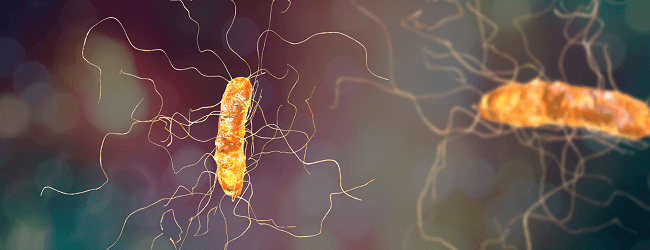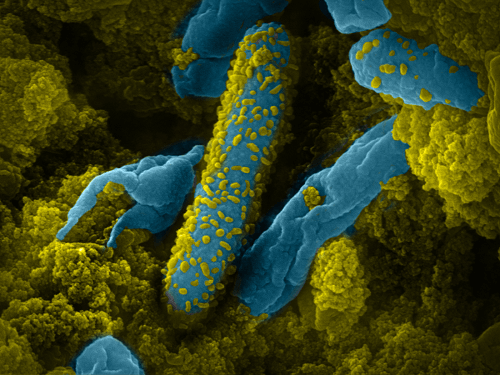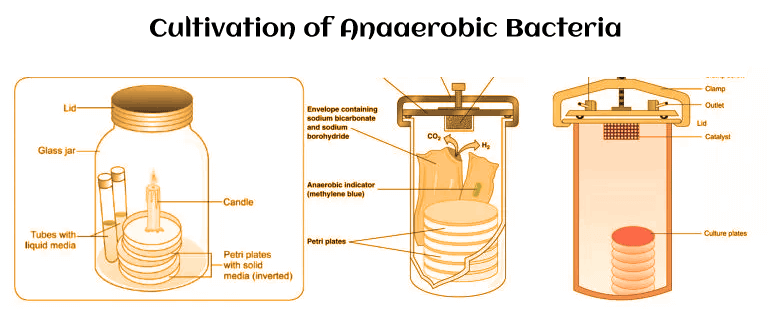Anaerobic BacteriaThe technique by which bacteria meet their energy requirements is reflected in their oxygen requirements. Obligatory anaerobes do not perform oxidative phosphorylation. Anaerobic bacteria are prone to oxygen because they do not have enzymes like peroxidases, catalases, superoxide dismutase, etc. These enzymes help the bacteria detoxify the free radicals of oxygen and peroxide created during metabolism in the presence of oxygen. Examples of anaerobic respiration are fermentation and glycolysis. 
Glycolysis and fermentation are examples of anaerobic respiration. These enzymes detoxify peroxide and oxygen free radicals created during metabolism in the presence of oxygen. NADH (produced during glycolysis) is transformed back to NAD by losing hydrogen during the last stages of the process. When adding hydrogen ions to pyruvate, a large range of metabolic products are formed. These products depend upon different bacterial species. Based on the oxygen requirement, bacteria can be classified into various groups. These are as follows - Many metabolic end-products are formed when hydrogen is added to pyruvate, depending on the bacterial species. Bacteria can be classified into the following groups based on their oxygen requirements:
On the other hand, there are bacterial species that cannot live in the presence of oxygen because they do not have that different system. These bacterial species are called obligate anaerobic bacteria. The bacterium's capacity to detoxify superoxide and hydrogen peroxide, which are generated due to aerobic respiration, is linked to its oxygen tolerance. In aerobic conditions, glucose absorption leads to the production of a free radical called superoxide (O2). The conversion of superoxide into oxygen gas and hydrogen peroxide is carried by an enzyme called superoxide dismutase. Hydrogen peroxide thus produced in this process is very toxic to the cell, and it is transformed into water and oxygen with the help of enzyme catalase. ClostridiaClostridiumClostridium tetanus is a gram-positive rod with a terminal spore. This may be found in soil, dust, and animal feces. Contamination of wounds, which offer anaerobic conditions, can result in spore germination and tetanus, an uncommon but deadly illness. Tetanus is also known as lockjaw because of the patient's inability to open their mouth due to muscular paralysis. When spores (found in soil, dung, or saliva) penetrate wounds or scrapes, they germinate and generate tetanus toxin, which causes infection. Since the organism is non-invasive, it stays in the wound. Tetanospasmin, an exotoxin, binds to ganglioside receptors on inhibitory neurons in the brain. The toxin's action, which prevents the release of inhibitory neurotransmitters (glycine and gamma-aminobutyric acid), causes widespread tetanus-like muscle spasms. This causes spastic paralysis by interrupting nerve impulse transmission to muscle. The toxin can affect the endplates of peripheral motor nerves, the brain, the spinal cord, and the sympathetic nervous system. It travels via the axon and synaptic connections before reaching the central nervous system. Due to the involvement of inhibitory neurons, the muscle contractions are unopposed. The most frequent kind of tetanus is generalized tetanus, which causes lockjaw (trismus). Cephalic tetanus is a very uncommon illness that affects the middle ear. It has the potential to impact the cranial nerves. In this condition, the patient gives an appearance of a sardonic smile because jaw muscles become tight, and it is very difficult to swallow something or even open the mouth. Local tetanus is also uncommon because it causes localized muscular spasms in the infection location. 
Clostridium perfringens is a bacterial infection caused by the bacteria Clostridium per fringe, also called Gas Gangrene. It is a gram-positive, rod-shaped bacteria that are found to cause wound colonization. After its invasion, several enzymes involved in the degradation of tissues are produced in the cell. Examples of these enzymes are proteolytic and saccharolytic enzymes. The outcome is necrosis and destruction of blood vessels and surrounding tissue, particularly muscle (myonecrosis is a kind of necrotic injury to muscular tissue). This produces an anaerobic environment in nearby tissue, allowing the organism to propagate throughout the body. Botulinum toxin (Botulism)Clostridium botulinum causes a dangerous paralytic sickness. The toxin introduced by the bacteria attaches to the receptor on peripheral nerves. At this point, acetylcholine, which is a neurotransmitter, is affected, and there is a blockage of nerve impulses. All these effects result in paralysis and, in extreme cases, even the individual's death. Although the organism does not thrive in the stomach, but insufficiently autoclaved canned food may include pre-formed exotoxin from past spore germination (usually at home). The condition has a modest occurrence, but it is of great concern because of its high fatality rate if not treated promptly and appropriately. Botulism can be avoided by employing food preservation techniques designed to stop C. botulinum from growing. Heat labile, the poison can be eliminated by heating it to 80°C for 10 minutes or more. Low acid (pH > 4.4) canned goods, for example, are heat-processed at 121°C for 3 minutes (the "botulism cook") or comparable. Clostridium difficile (Colitis Pseudomembranous)This bacterium is a causal organism of many intestinal disorders like antibiotic-associated diarrhea, colitis, and pseudomembranous colitis in humans. These disorders are caused by Clostridium difficile overgrowth in the colon, which commonly occurs after antimicrobial treatment has disrupted the normal intestinal microbiota ecology. C. difficile illness seldom affects people who are in good health. Individuals with various diseases that necessitate the use of antibiotics for an extended period and the elderly are the most vulnerable. Also at risk are people who have recently had gastrointestinal surgery, have a major underlying condition, or are immunocompromised. C. difficile makes two types of toxins. Toxin A is classified as an enterotoxin because it causes intestinal fluid build-up. Toxin B is a cytopathic toxin that is exceedingly deadly. Anaerobic Bacteria Diagnosis in The LaboratoryAnaerobes are generally located in certain parts of the body, but when they get access to normally sterile body fluid or poorly oxygenated deep tissue, they can cause significant illness. Anaerobes can be found in the skin's fissures and the nose, mouth, throat, gut, and vaginal canal. The main reason these bacteria enter the sterile part of the body is through injury to the tissues. These injuries could be cuts, trauma, or any puncture wound, which are usually near the mucous membrane and allow the entry of bacteria into the body, followed by the infection. The introduction of spores into a typically sterile environment is the second cause of anaerobic infection. 
Anaerobes that produce spores dwell in the soil and water, and spores can be spread through wounds, particularly punctures. Anaerobic infections are particularly common among immune-compromised people, people who have recently been treated with broad-spectrum antibiotics, and those who have rotting tissue damage on or near a mucous membrane, especially if the place smells bad. Anaerobe identification is extremely difficult, and laboratories may utilize various methods. The colonial and microscopic morphology of organisms is used to identify them. Collection Of Anaerobic Infections SpecimenThe essential requirement for efficiently preserving anaerobic bacteria culture is the collection of samples that are contamination-free and then preserving them outside the oxygen exposure. During the collection, it should be ensured that the culture is not contaminated with surrounding skin, tissue, or mucous membrane. The bacterial culture should be acquired from a very suitable location. Since the cotton fibers are not suitable for anaerobic bacteria, swabs should be avoided while collecting the specimens for anaerobic culture. Instead of cotton, a sterile syringe can be used for collecting the sample, but it should be noted that it is close enough so that air is not entered. At last, while storing the tissue sample, it should be noted that air is not getting in by placing the tissue sample in a degassed bag or firmly capped gassed out vial already containing oxygen-free pre-reduced culture media. Plates should be applied to the specimens as soon as feasible. Gram Stain for Anaerobic BacteriaAnaerobes with a gram-positive phenotypeThe following are examples of gram-positive anaerobes:
Clostridium tetani is a gram-positive, motile bacterium that produces spores. The organism generates terminal spores within a swelling sporangium, giving it a drumstick appearance. Despite having a gram-positive cell wall, the bacteria can stain gram-negative or gram-variable cells, especially in elderly cells. Clostridium botulinum is a big, gram-positive, spore-forming, motile anaerobic bacterium with a rod-shaped morphology. Cultivation Of Anaerobic BacteriaAn anaerobic bacterium culture is a method for cultivating anaerobes from clinical samples. There are bacterial species that can only survive in the absence of oxygen. These bacteria are called obligatory anaerobic bacteria. Even a little exposure to the atmosphere, like 10 minutes, is enough to kill them. However, some anaerobic species can tolerate a small amount of oxygen. These bacteria are known to live both with and without oxygen and are called facultative anaerobes. Different techniques and procedures are carried out while culturing to ensure that the bacteria are not exposed to oxygen. 
Bacteria, known as obligatory anaerobes, can only survive without oxygen. They are destroyed when forced anaerobes are exposed to the atmosphere for as little as 10 minutes. Some anaerobes tolerate small levels of oxygen. Organisms that can thrive with or without oxygen are known as facultative anaerobes. To guarantee that the organisms are shielded from oxygen, the techniques for acquiring specimens for anaerobic culture and the culturing procedure are carried out. The sample for culture must be obtained in an aseptic manner by the health care practitioner. Anaerobes can be found on mucosal membranes and other places, including vaginal and oral cavities. Anaerobic Growth MediaTo begin growing, most stringent anaerobes require the absence of oxygen and redox potential of less than -300mV, which can only be reached by supplementing media with reducing chemicals. Thioglycolate broth is a multi-purpose, enhanced differential medium mostly used to evaluate microorganism oxygen needs. Sodium thioglycolate in the medium depletes oxygen, allowing obligate anaerobes to thrive. This, together with oxygen diffusion from the top of the broth, results in various oxygen concentrations in the medium at different depths. A redox-sensitive dye like resazurin, which becomes pink in the presence of oxygen, indicates the oxygen content at a specific level. Reducing media reduce molecular oxygen (O2) from the environment, which may interfere with anaerobe development. Thioglycolate reacts with dissolved oxygen in the medium to deplete it. A nonselective blood agar plus one or more of the selective media listed below are used as the major plating media for inoculating anaerobic specimens. In anaerobic bacteriology, nonselective mediums are used:
In anaerobic bacteriology, selective and differential media are used:
Anaerobic bacteria require special cultivation procedures -Candle jarA microaerophile is a microbe that needs oxygen to thrive but only in settings with lower oxygen levels than those found in the atmosphere (20 percent concentration). 
Since they require a high concentration of carbon dioxide, many microphones are also capnophiles. They may readily be grown in a candle jar in the laboratory. A candle jar is a container into which a lit candle is placed before the closed airtight lid. The candle's flame burns until it is extinguished by oxygen deprivation, leaving the jar with a carbon dioxide-rich but oxygen-poor environment. Candle jars cultivate microorganisms that require a higher CO2 concentration (capnophiles). Candle jars raise CO2 levels while leaving some O2 for aerobic capnophiles. Many labs also have direct access to carbon dioxide and may directly add the required carbon dioxide levels to incubators where microaerophiles are being grown. Gas packGas packs may also produce CO2 and are commonly used instead of candle jars. A Petri plate and a CO2 gas generator are included in the bundle. The gas generator is smashed to mix the chemicals and begin the CO2 production process. This gas lowers the oxygen content in the bag to around 5% and increases the CO2 concentration to around 10%. Anaerobic jarAn anaerobic jar or an anaerobic chamber can be used to incubate petri plates. CO2 and H+ are produced by mixing sodium bicarbonate and sodium borohydride with little water. To remove O2, a palladium catalyst in the jar reacts with the O2 and H+ in the jar. Biological approachTo create anaerobic conditions, a biological technique might be used. A wax or paraffin-sealed petri dish is cultivated in an aerobic environment. The examined material is injected into half of the solid medium in the petri dish. In contrast, the other half is infected with Serratia marcescens, anaerobic bacteria capable of producing an anaerobic environment by consuming oxygen.
Next TopicNitrogen Fixing Bacteria
|
 For Videos Join Our Youtube Channel: Join Now
For Videos Join Our Youtube Channel: Join Now
Feedback
- Send your Feedback to [email protected]
Help Others, Please Share










